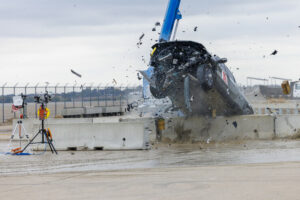
Guardrail failed to stop EV truck in safety facility crash test
By onAnnouncements
A 7,000-plus-pound electric truck tore through a guardrail with little speed reduction during a crash test conducted by the Midwest Roadside Safety Facility at the University of Nebraska-Lincoln, a university press release said.
The university is researching how roadway safety infrastructure performs during electric vehicle (EV) crashes. The research is sponsored by the U.S. Army Engineer Research and Development Center, the release said.
The release claims the test is the first-of-its-kind test using an EV pickup truck. The weight of battery packs used in EVs is known to cause the vehicles to be heavier.
“There is some urgency to address this issue,” said Cody Stolle, assistant director of the Midwest Roadside Safety Facility. “As the percentage of EVs on the road increases, the proportion of run-off-road crashes involving EVs will increase as well.”
The crash test on Oct. 12 used a 2022 Rivian R1T truck driving at 60 mph. The university also tested a 2018 Tesla Model 3 sedan in September. The Tesla lifted the guardrail and passed below it, the release said.
During a special presentation at the Collision Industry Conference (CIC)’s April meeting in Richmond, Virginia, Insurance Institute for Highway Safety (IIHS) Senior Test Coordinator Sean O’Malley said the most recently weighed EV, a 2023 Rivian R1S, came in at more than 7,000 pounds — almost 3,000 pounds more than a 2023 Honda Civic. That’s a difference in weight equivalent to a 2023 Ford Ranger.
The Midwest Guardrail System (MGS) used for the university’s study was 12-gauge corrugated steel attached to 6-inch deep steel posts, anchored to the rail with blockouts 8- to 12-inches thick, the release said. It said the top of the rail was 31 inches above the road.
“The MGS has been tested with small cars that weigh up to 2,400 pounds and pickups that weigh 5,000 pounds,” the release said. “Up until now, little has been known about how the system will perform in crashes involving EVs, which typically weigh 20% to 50% more than gas-powered vehicles, with lower centers of gravity.”
Stolle told the Associated Press (AP) that more crash testing and computer simulation research is planned. He said research will help the facility develop a system that minimizes damage to both EV and internal combustion engine (ICE) vehicles.
“It could be concrete barriers,” Stolle said in the AP article. “It could be something else. The scope of what we have to change and update still remains to be determined.”
Stolle said the facility redesigned guardrails in the 1990s as consumers purchased more SUVs and trucks.
Bloomberg reported last year that ICE SUVs and trucks are also getting heavier. The average weight of a new vehicle sold in the U.S. in 2022 was 4,329 pounds, about 175 pounds heavier than in the three previous model years, it said.
In 2021, IIHS began using a new side impact test because SUVs were heavier, which meant increasing the weight of the barrier that runs into the vehicle and its speed.
In 2022, IIHS tested its propulsion system to ensure it could handle heavier EVs. It did so by adding 9,500 pounds of heavy steel plates and concrete blocks onto an F-150 and seeing whether it could reach the target speed of 40 mph for frontal, small, and overlap crashes on both sides of vehicles. The test proved the system’s ability to tow a vehicle at that speed for the frontal crash.
Images
Photo courtesy Craig Chandler/University of Nebraska-Lincoln Communication and Marketing
